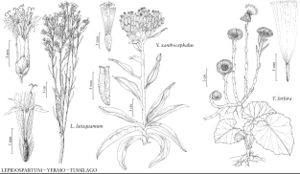Tussilago
Sp. Pl. 2: 865. 1753.
Gen. Pl. ed. 5, 372. 1754.
| Taxon | Illustrator ⠉ | |
|---|---|---|
 | Lepidospartum latisquamum Yermo xanthocephalus Tussilago farfara | Linny Heagy Yevonn Wilson-Ramsey Yevonn Wilson-Ramsey |
Perennials, 5–30 (–50) cm (rhizomes fibrous-rooted, creeping; plants forming extensive colonies). Stems usually 1, erect (scapiform, not branched). Leaves basal and cauline (basal usually developing after flowers); alternate; petiolate (petiole lengths 1–2 times blades) or sessile; blades (basal) palmately nerved, orbiculate to polygonal or lobed (cauline leaves lanceovate to linear, bractlike or scalelike), margins denticulate, abaxial faces gray-tomentose, adaxial tomentulose, glabrescent. Heads (erect at flowering, nodding in fruit) radiate, borne singly. Calyculi 0 (or indistinct, bractlets intergrading with bractlike cauline leaves). Involucres cylindric to subturbinate, 10–15 mm diam. (larger in fruit). Phyllaries persistent, usually ± 21 in (1–) 2 series, erect, distinct, lance-linear to linear, subequal, margins scarious (apices greenish or yellow-green). Receptacles convex, foveolate (socket margins ± membranous), epaleate. Ray-florets 100–200 (–300+), pistillate, fertile; corollas yellow (drying pinkish). Disc-florets (20–) 30–40, functionally staminate; corollas yellowish, tubes longer than campanulate throats, lobes 5, erect, linear; styles not divided. Cypselae narrowly cylindric or ± prismatic, 5 (–10) -ribbed, glabrous; pappi readily falling or fragile, of 60–100+, white, barbellulate or smooth bristles. x = 30.
Distribution
Introduced; temperate Eurasia, n Africa
Discussion
Species 1.